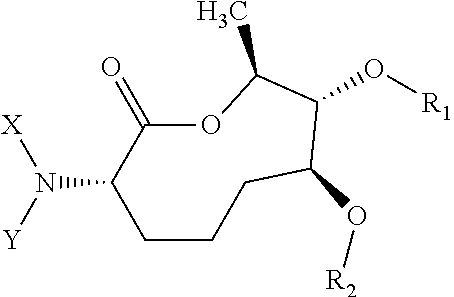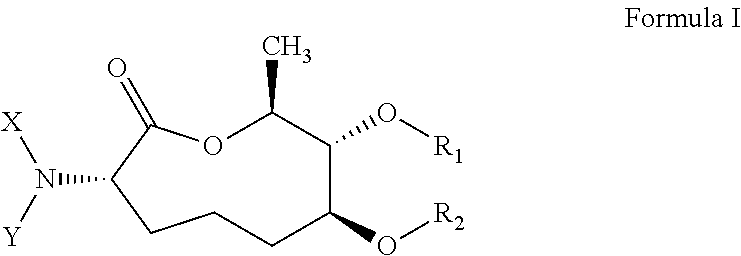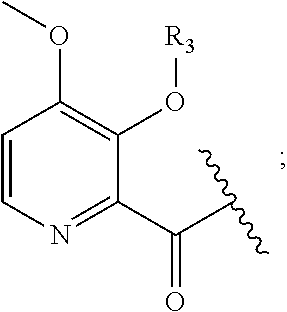Macrocyclic picolinamides as fungicides
- Summary
- Abstract
- Description
- Claims
- Application Information
AI Technical Summary
Benefits of technology
Problems solved by technology
Method used
Image
Examples
example 1
Preparation of (2S,3R,4S)-2-methyl-3,4-dihydro-2H-pyran-3,4-diol (C1)
[0123]
[0124]To a solution of (2S,3S,4S)-2-methyl-3,4-dihydro-2H-pyran-3,4-diyl diacetate (32.10 grams (g), 150 millimole (mmol)) in MeOH (150 milliliters (mL)) was added K2CO3 (2.07 g, 15.0 mmol). This mixture was stirred for 16 h at 20° C. The resulting yellow solution was filtered through a plug of silica gel, 6 centimeters (cm)×2 cm, that was flushed with EtOAc (500 mL). The solvent was concentrated to provide (2S,3R,4S)-2-methyl-3,4-dihydro-2H-pyran-3,4-diol (19.9 g, 102% yield with 95% purity resulting in 97% corrected yield) as a yellow solid, which was used without further purification: 1H NMR (400 MHz, CDCl3) δ 6.31 (dd, J=6.0, 1.6 Hz, 1H), 4.70 (dd, J=6.0, 2.1 Hz, 1H), 4.21 (dt, J=7.4, 1.9 Hz, 1H), 3.85 (dq, J=9.9, 6.3 Hz, 1H), 3.41 (dd, J=9.9, 7.4 Hz, 1H), 1.38 (d, J=6.3 Hz, 3H); 13C NMR (101 MHz, CDCl3) δ 144.82, 102.65, 75.64, 74.36, 70.34, 17.09; EIMS m / z 130 ([M+]).
example 2
Preparation of (2S,3S,4S)-3,4-bis(benzyloxy)-2-methyl-3,4-dihydro-2H-pyran (C2)
[0125]
[0126]Sodium hydride, 60% dispersion in mineral oil, (NaH; 14.68 g, 367 mmol) was added to a 1 liter (L), 3-neck round bottomed flask under nitrogen. The NaH dispersion was washed with hexanes (100 mL and 50 mL) and then suspended in anhydrous N,N-dimethylformamide (DMF; 230 mL) and cooled to 0° C. in an ice water bath. The flask was fitted with a 125 mL addition funnel that was then charged with (2S,3R,4S)-2-methyl-3,4-dihydro-2H-pyran-3,4-diol (19.9 g, 153 mmol) as a solution in anhydrous DMF (70 mL). The diol solution was added to the NaH suspension dropwise with modification of the flow rate to mitigate the reaction rate and frothing. The addition took a total of 15 minutes (min). This mixture was then stirred at 0° C. for a further 30 min. The addition funnel was charged with benzyl bromide (40.0 ml, 336 mmol) that was added dropwise over 10 min. The mixture was then allowed to slowly warm to 2...
example 3
Preparation of (3R,4S,5S)-3,4-bis(benzyloxy)-5-methyltetrahydrofuran-2-ol (C3)
[0127]
[0128]To a solution of (2S,3S,4S)-3,4-bis(benzyloxy)-2-methyl-3,4-dihydro-2H-pyran (41.8 g, 135 mmol) in CH2Cl2 (405 mL) and MeOH (50 mL) was added NaHCO3 (1.13 g, 13.5 mmol). This mixture was cooled to −78° C. (dry ice / acetone bath) and a stream of ozone was passed through the reaction until the solution took on a blue color (2 h). Oxygen was passed through until the blue color disappeared (10 min) and then dimethyl sulfide (19.9 ml, 269 mmol) was added. The solution was warmed to 20° C. and stirred overnight. The reaction was filtered through a plug of Celite® and concentrated to provide an oil. This oil was dissolved in THF (300 mL), a solution of LiOH (9.68 g, 404 mmol) in water (150 mL) was added, and the mixture was stirred vigorously at 20° C. for 2.5 h. The phases were separated and the aqueous phase was extracted with EtOAc (2×100 mL). The combined organic extracts were washed with saturated...
PUM
| Property | Measurement | Unit |
|---|---|---|
| Composition | aaaaa | aaaaa |
Abstract
Description
Claims
Application Information
 Login to View More
Login to View More - R&D
- Intellectual Property
- Life Sciences
- Materials
- Tech Scout
- Unparalleled Data Quality
- Higher Quality Content
- 60% Fewer Hallucinations
Browse by: Latest US Patents, China's latest patents, Technical Efficacy Thesaurus, Application Domain, Technology Topic, Popular Technical Reports.
© 2025 PatSnap. All rights reserved.Legal|Privacy policy|Modern Slavery Act Transparency Statement|Sitemap|About US| Contact US: help@patsnap.com



